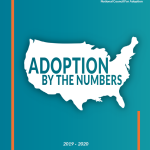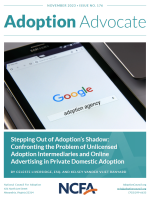
Stepping Out of Adoption’s Shadow: Confronting the Problem of Unlicensed Adoption Intermediaries and Online Advertising in Private Domestic Adoption
Adoption Advocate No 176

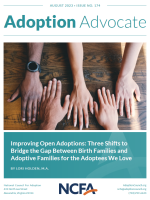
Adoption creates a split between a person’s biology and biography, and openness is an essential way to help adoptees heal this split.1
This article covers what openness means in the context of adoption and how adoptive parents can, through openness, help adoptees
integrate and heal. There are three shifts adoptive parents can make—supported by adoption professionals—to better focus on
what really matters. This article addresses situations faced by adoptive parents who have contact with birth parents, those who do not
and feel that is just as well, and, finally, those who wish to be in contact with birth parents but, for various reasons, are not.
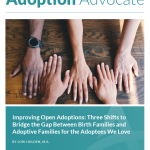
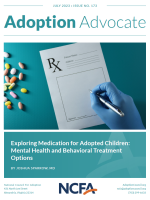
Exploring Medication for Adopted Children: Mental Health and Behavioral Treatment Options
Published by the Adoption Advocate, July 2023, Issue Number 173
The adoption community has made great progress in understanding the impact of trauma on children’s mental health and emotional well-being. As more adoptive parents seek healing for their children through mental health services, they are part of an overall rise in the general population of children and adolescents whose mental health and behavioral treatment plans involve medication. In this issue of the Adoption Advocate, child psychiatrist Joshua Sparrow outlines common concerns and considerations for psychotropic medications, when to worry, tips for observing, describing, and understanding your child’s behavior, and how to develop a team approach for parents, children, doctors, and teachers.
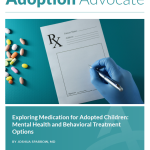

Adoption Advocate
Prenatal Stress, Preverbal Trauma, and
Developmental Trajectories: The Importance of
the Attachment Relationship
The impact of prenatal stress and preverbal trauma on developmental trajectories is
both a topic of education and area of treatment focus in my clinical
practice. As a specialist in infant and early childhood development, as well as trauma
and attachment disorders, I often work with children who present with a variety of
surfacelevel symptoms that are, at their core, the effects of prenatal, preverbal,
or developmental trauma. I often discuss with parents the potential longterm
ramifications, and the hope and healing that arly intervention can bring.

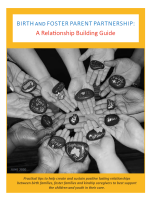
It is always better for children and youth to remain with their birth families if it is safe to do so. When foster care is necessary, the goal is to provide a temporary safe, stable and nurturing environment for children and adolescents while actively seeking and supporting reunification with their families. A robust relationship between a child or youth’s birth parents and foster parents or kinship caregivers can help achieve this outcome and reduce trauma for everyone. These relationships are best nurtured when child welfare staff, parent partners, court and legal personnel, court advocates, foster parent organizations and other service providers are supportive and help facilitate early and ongoing communication.
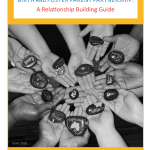
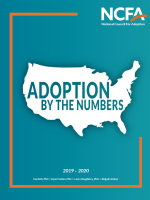
This National Council For Adoption (NCFA) research report presents data on the number of adoptions in the United States in 2019 and 2020. Data on the
number of private domestic adoptions, intercountry adoptions, and adoptions from foster care are compiled in aggregate as well as at the state level, thus providing an estimate of the total number of adoptions in the United States.
